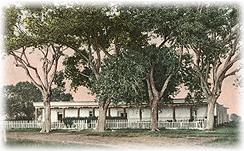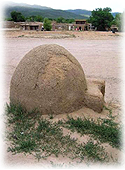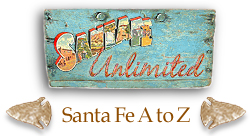|
|||
 Hacienda HaciendaThe Spanish word for "estate," a hacienda was usually a large ranch or plantation. Today, in New Mexico, a hacienda depicts a type of Southwestern home, usually a large and rambling adobe home on at least an acre of land. (~Aimee) Hat (Cowboy) The Cowboy Hat has become so iconic that it can be worn virtually anywhere in the world and receive immediate recognition. Before the invention of the cowboy hat by John B. Stetson, cowpunchers of the plains states wore hats leftover from previous occupations. Top hats, derbies and Civil War caps, as well as tams and sailor caps were all worn in the early days of the Western frontier. The first cowboy hat was designed in 1865. As the story goes, John B. Stetson (and some of his companions) went West to seek the benefits of a drier climate. During a hunting trip, Stetson amused his friends by showing them how he could make cloth out of fur without weaving. After creating his fur flannel, Stetson continued the joke by making an oversized hat with an enormous brim. But he, and his company, noticed that the hat would be useful in protecting the wearer from rain and sun. Stetson decided to wear the hat on his hunting trip. He was so happy with the outcome, that he continued wearing it on his travels throughout the West. In 1865, he began producing the first line of his oversized hats, and before long, his "joke" became known as the cowboy hat. The original Stetson hat sold for five dollars. Today, the cowboy hat is a link to the Old West, lending its wearer an air of rugged individuality and playful enjoyment that still rings of Stetson’s humorous invention. (~Aimee)  A Bit of Cowboy Hat Movie Trivia: In the 1960s Doris Day movie, “Pillow Talk,” Rock Hudson’s fake Texan persona is named “Rex Stetson,” although he never wears a cowboy hat in the film’s New York City setting. Hudson did, however, succeed extremely well in impersonating a Texas oilman, making the sex-farce comedy one of the top box office hits of the year. In one piece of dialogue he tells Day that being with her is "like sitting around a pot-bellied stove on a cold, winter mornin'." Now, that's a real down-home compliment, if I ever heard one! (~Jean) A Bit of Cowboy Hat Movie Trivia: In the 1960s Doris Day movie, “Pillow Talk,” Rock Hudson’s fake Texan persona is named “Rex Stetson,” although he never wears a cowboy hat in the film’s New York City setting. Hudson did, however, succeed extremely well in impersonating a Texas oilman, making the sex-farce comedy one of the top box office hits of the year. In one piece of dialogue he tells Day that being with her is "like sitting around a pot-bellied stove on a cold, winter mornin'." Now, that's a real down-home compliment, if I ever heard one! (~Jean)Highfalutin Definition: “Pompous or pretentious speech, writing, or ideas.” Origin: “mid-19th century, during the period of the populating of the Old West.” (~Jean)  Historical-Hysterical Parade The Desfile de la Fiesta is one of the last events of the Santa Fe Fiesta. Also called the Grande Parade or the Historical-Hysterical Parade, anything and everything goes at this lively event, where prizes are awarded in several categories. (~Jean) Horno Spanish for "oven." In the Southwest, horno generally refers to a wood-fired oven made of adobe mud, often in the shape of a beehive. Native Americans still use the outdoor horno to cook a special delicacy called "fry bread." Recently, dog houses have been made in the igloo shape of a horno, for those Santa Fe and Taos residents who want their pooches to enjoy New Mexico style. (~Aimee) Howdy Definition: “An informal friendly greeting, particularly associated with the Western United States, as in ‘howdy, stranger.’ ” Origin: 1820–1830; from the phrase “how do ye?” It is typically associated with the American Southern accent, especially from Texas, Oklahoma, Kansas, Tennessee, Louisiana, Alabama, North Carolina, Georgia, and Mississippi. It is also a well-known phrase, as used by cowboys in early- to mid-20th century Western movies. (~Jean)  A Bit of Baby Boomer Howdy Trivia: Gosh, how I dreamed of being on “The Howdy Doody Show”! Oh, to be a part of the “Peanut Gallery” while Howdy and Buffalo Bob did their thing! Of course, it wasn’t possible, as I lived in the heartland of America, far, far away from the big city studio where the show was produced. We did, however, have a local kiddie show that was hosted by “Foreman Scotty” (one of the station’s newsmen). The highlight of our show was when they would move the camera around on the rows of kids and whoever it stopped on would win the “Lucky Horseshoe.” One of my close friends actually won it, and all us kids just stared at it in awe. Those were the days. (~Jean) A Bit of Baby Boomer Howdy Trivia: Gosh, how I dreamed of being on “The Howdy Doody Show”! Oh, to be a part of the “Peanut Gallery” while Howdy and Buffalo Bob did their thing! Of course, it wasn’t possible, as I lived in the heartland of America, far, far away from the big city studio where the show was produced. We did, however, have a local kiddie show that was hosted by “Foreman Scotty” (one of the station’s newsmen). The highlight of our show was when they would move the camera around on the rows of kids and whoever it stopped on would win the “Lucky Horseshoe.” One of my close friends actually won it, and all us kids just stared at it in awe. Those were the days. (~Jean)Pictured top to bottom: 1} An example of a classic New Mexican hacienda; 2} A horno at picturesque Taos Pueblo |
|||
Home | Food | Lodging | Merchants | Services | Real Estate | Art & Galleries | Entertainment | Recreation Ski Areas | Mind-Body-Spirit | Santa Fe Information | Local Color | Canyon Road | The Turquoise Trail | Santa Fe Plaza The Pueblos | Scenic Beauty | Day Trips | Chili | Special Events | Santa Fe History | Multicultures | Museums High Road to Taos | The Wild West | Churches | Plants & Wildlife | Santa Fe Railyard | Turquoise | Architecture Fiesta | Indian Market | Spanish Market | Zozobra | Features | About Us | Get Listed! | Santa Fe Unlimited Trading Post Photo of the Week | Link of the Month | Testimonials | Santa Fe Webcams | Santa Fe Weather Santa Fe A to Z | Movie Locations | Santa Fe Unlimited Guestbook | Sitemap | Contact Us | Taos Unlimited All original graphics and content of this website, unless otherwise indicated, are copyright © 2006-2011 Santa Fe Unlimited and may not be reproduced in any fashion. |
|||

